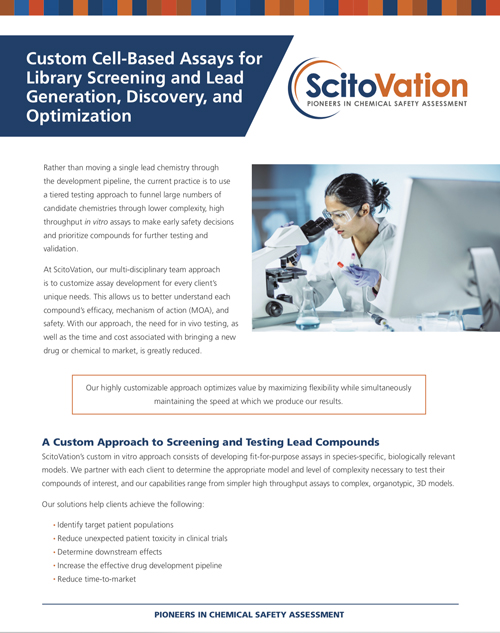Screening and Assessing Lead Compounds
We help clients with screening and characterizing the safety or efficacy of lead compounds using in vitro methods. We use a range of assays and appropriate cell lines that meet the client’s objective. Our choice of assays and cell lines depend on the questions our clients seek to answer. Screening of compounds:
We use simple in vitro cell-based assays that can be used for:
- Initial screening of compounds for ‘go/no-go’ based decision making
- Ranking compounds based on their cytotoxicity or another endpoint of interest
- Initial range finding for determining concentrations of compounds to be used for more complex experiments (e.g., acute studies, transcriptomic assays, mechanism-based specific end point assays)
An example of a simple assay for screening is a version of the HepG2 cytotoxicity and viability assay on the specific compounds a client is evaluating. We can screen tens or hundreds of compounds simultaneously with a dose-response reported for each of the compounds. As appropriate, this system can be adapted to include any number of known positive and negative controls or other reference standards.
Using this test protocol, we can measure toxicity at 4, 24, 48, 72 hours after compound administration. Endpoint of main interest to client is considered. Compound potency or equivalent human exposure under normal use are also factors considered.
The inclusion of a relevant simple assay in the workflow will lead to the identification of lead compounds that are less likely to fail compared to using QSAR alone. Depending on the amount of data collected (number of endpoints and frequency of the measurements), the cost can be kept relatively low per batch, up to 30 compounds. Given the cost of conducting this test, we can eliminate compounds with less desirable results.
Assessing Lead Compounds
For lead compounds or compounds already in the market, we can characterize safety or concerns by looking at endpoints ranging from simple to more complex including cell viability, cell cycle, kinetic proliferation, integrated stress response or mitochondrial fragmentation. To conduct these assays, we have access to high end equipment including a Phoenix Opera (high content imaging). While we study various organs, we have expertise in liver and respiratory systems. For respiratory systems, we developed assays for exposure to aerosols and vapors. When necessary, we can develop customized assays to measure an endpoint of interest. An example is a case involving endocrine disruption.

Case Study: Assessing carcinogenicity and liver toxicity of fluoro-carbons compounds
